Contactless Access Control is the Key for Today’s Security Entrance Lanes
Mike McGovern, PSP
Automatic Systems
Frank Scala, PSP, CTS
WSP USA
January 2021
| How to be secure, safe, healthy, and beautiful? Maybe just add “happy” and we have a common New Year’s resolution for many of us, right? Well, the first 4 of these (we’ll save happy for others to address!) are also goals for security entrance control products going into 2021 – challenges which must be addressed in a balanced way. | ||
|
| There are many new developments in readers and authentication technology. We now have 2D barcode readers, advanced |
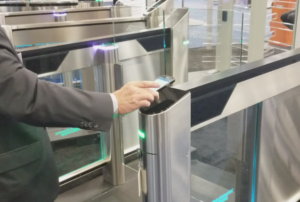 Smartphone access systems Like HID’s blend well with SlimLane EPR Swing Glass Smartphone access systems Like HID’s blend well with SlimLane EPR Swing Glass |
smartphone technology, superior biometrics and AI (artificial Intelligence) systems for credentialing. In this article we examine how some of the latest advances in authentication and credentialing are perfectly integrated and blended into security entrance portals, turnstiles, and gates.
Sure, it was always nice to say that we have clean security access products that won’t spread germs or require frequent cleaning. But the authors observe now that what had been “a want” is now “a clear need”. Preventing the spread of diseases and contact tracing have become goals previously never discussed when considering entrance control solutions. |
| Today’s security designers, consultants and technology engineers almost need a window to the future, a crystal ball of sorts. Future-ready solutions are demanded by today’s and tomorrow’s smart building technology focus. |
| The security designer must manage demands such as maintaining high quality product selections with smart connectivity, budget constraints, future focused, beautiful…..and now we must provide hygienic focused designs too!
Generally, architects and security technology designers work together to design the best solution for their client. But Architects are focused on day one operations and aesthetics while technology consultants are more concerned with long term technical functionality and supporting/integrating with new smart building systems. Speed, security, appearances – and recently the need for hygienic solutions were already raising new challenges for the industry. The industry was moving in the right direction before we had COVID-19 to deal with, as evidenced by the many new technologies that were already being introduced prior to the year that was 2020. |
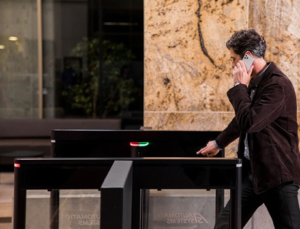
OpenPath’s unique system of wifi/Bluetooth/cellular allows users to access security lanes using their smartphones, even when phones are in use, in pocket, or app not open. |
| Security design engineers and consultants tell us that new approaches to authentication integration were necessary. |
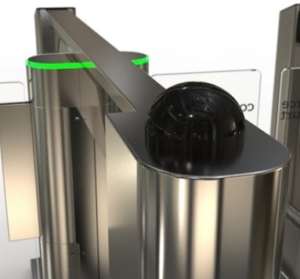
Facial Recognition reader systems like those from Idemia, Identytech and NEC are fitted into a SlimLane EPR swing glass optical turnstile |
Our co-author Frank Scala of WSP USA, his colleagues, and other technology consulting experts agree that new contact-free access is a must, not a want.
Jon Harris, PSP, CPP is Director of Enterprise Solutions at Guidepost Solutions LLC. He observed some current trends in contactless access control. As he says, “The COVID pandemic is driving the adoption of the contactless technologies that were already existing and readily available, however, they were previously viewed more as a novelty than providing security value.” Jon continues, “I project that trend will continue to be a lasting impact and legacy in our industry, as people have become used to this and may come to expect it. Entering a facility more quickly, with less friction or human intervention, the safe/secure environment is being realized without the onerous controls that had been historically required for the more secure environment.” Good Harbor Techmark’s Design and Engineering Principal Frank Gallagher had this comment regarding contactless entrance control: |
| “Due to the pandemic, we are seeing a trend in contactless entry – including an increased installation of turnstiles with biometric readers (facial, handwave, etc.) as well as the use of automatic and sliding doors. Automatic doors and turnstiles need to open upon presentation of a valid credential or biometric and touchless egress would be via a hand wave sensor – allowing the staff member to enter/egress the site without touching door handles, credential readers, etc.” |
| Manufacturers of entrance control devices have had to devote significant design engineering resources to the task of providing aesthetic and functional solutions that will be intuitive and easy to use. |
| UL 2593 and UL 325 certifications require speed gates and turnstiles to be engineered against entrapment and accidental contact of barriers with the users – so they already supported the “touchless” mission. But still many vehicle gates, security gates and pedestrian products like portals, mantraps, optical turnstiles and speed gates needed new design enhancements to contain and present the new credentialing methods in a way that maximizes the function and appearance of these new contactless systems.
Once thought of as a luxury, these technologies are now essential in a post COVID era. Considering the observed clear needs for better, faster, more secure and health focused authentication, and supported by the expert opinions of security consultants, we are certain that these new contactless credentialing systems are and will continue to be the continued strong focus for entrance control system manufacturers. |
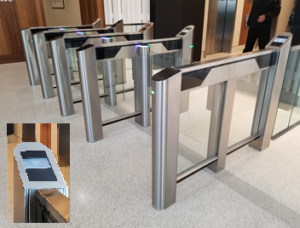
2D Barcode Readers (such as IBC’s Qscan-T) and Elevator Destination Dispatch Display Screens (i.e.; Otis, Schindler, ThyssenKrupp) beautifully blended with SlimLane EPR speed gate by Automatic Systems |
| Forward thinking applications engineering teams at entrance control makers are meeting the challenge. Elevator Destination dispatch screens are integrated into turnstile pedestal ends – no touch required – at an ergonomic 45 degree angle for viewing by the passing user. |
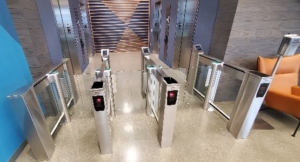
SmartPhone Readers, QR Code Readers and Elevator Destination Dispatch Screens integrated with SlimLane EP optical turnstiles for a true contactless experience in a smart building design |
Frictionless handwave readers are being deployed in slim swing glass optical turnstile designs at an increasing rate. Smartphone tracking and access control are seamlessly integrated into doors, turnstiles, portals, and parking gates. Facial recognition technology has improved greatly in recent years and can be tied into a speed gate turnstile in an effective and aesthetic design. Similarly, QR (2D barcode) readers, specialized turnstile (no-touch) multi-tech card readers, AI systems, and a variety of biometric readers are cleverly blended with entrance control devices in similar ways by quality entrance control system manufacturers, all of this while maintaining their needed UL 325 or 2593 certifications.
Tighter integrations between systems such as contactless access control and elevator destination dispatch will provide valuable in being future ready for smart buildings of tomorrow. |
The conclusions are clear concerning the new designs to make our access control experiences cleaner, safer and more efficient while maintaining security. These new contact-free, touchless authentication/credentialing systems – when combined with well-designed entrance control turnstiles and gates – are the new baseline for controlling access in 2021 and beyond.
The authors:
Mike McGovern, PSP is a Regional Sales Manager with Automatic Systems, a manufacturer of pedestrian and vehicle entrance control systems.
Frank Scala, PSP, CTS, is Technology Practice Lead for WSP USA Properties and Buildings, where he leads a technology and security design team for the Boston office.
|
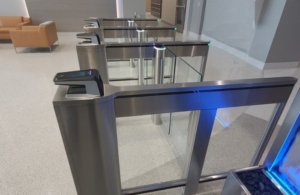 Architecturally minded security designers are managing competing goals of security, safety, health, and beauty into entrance control system
Architecturally minded security designers are managing competing goals of security, safety, health, and beauty into entrance control system
